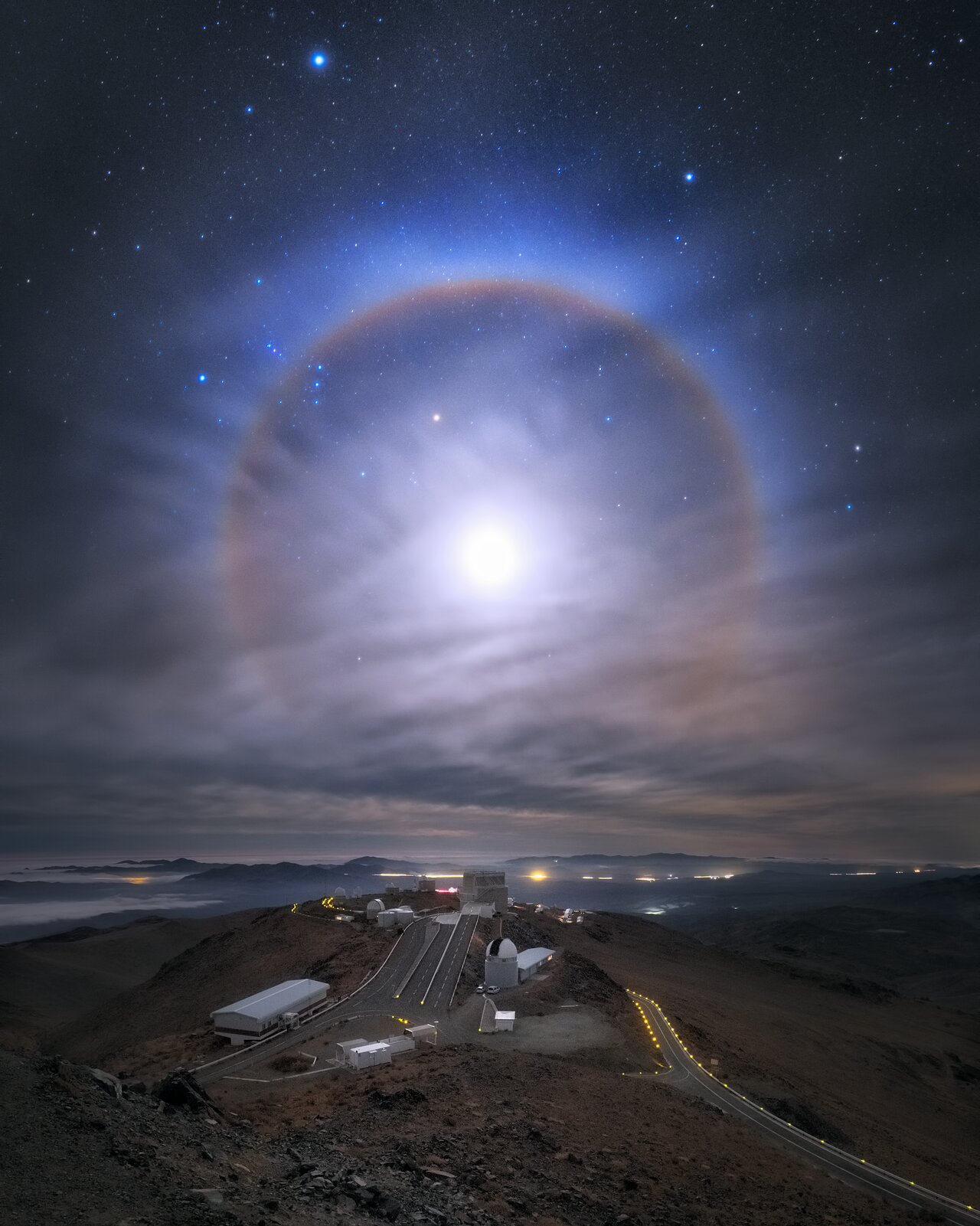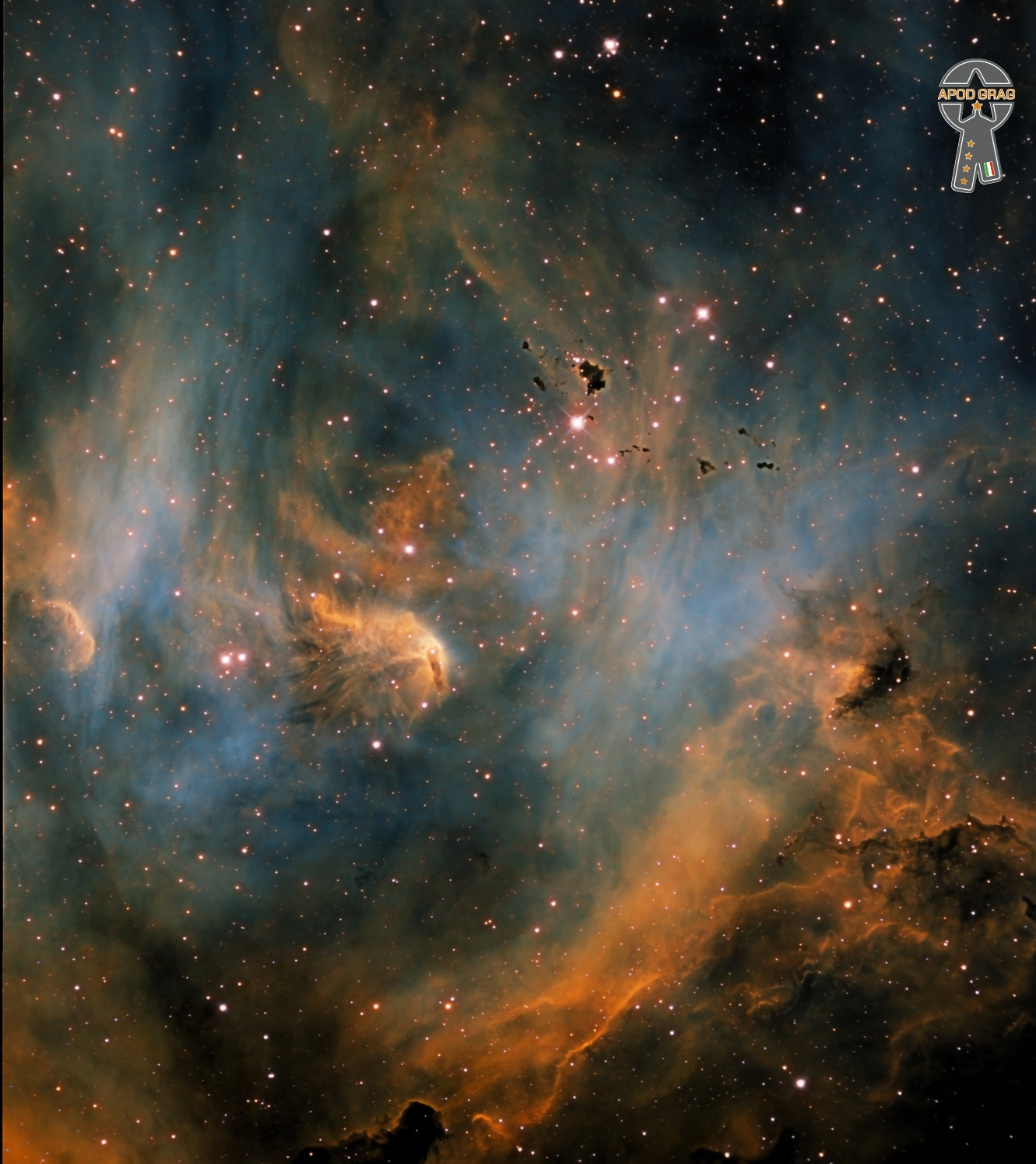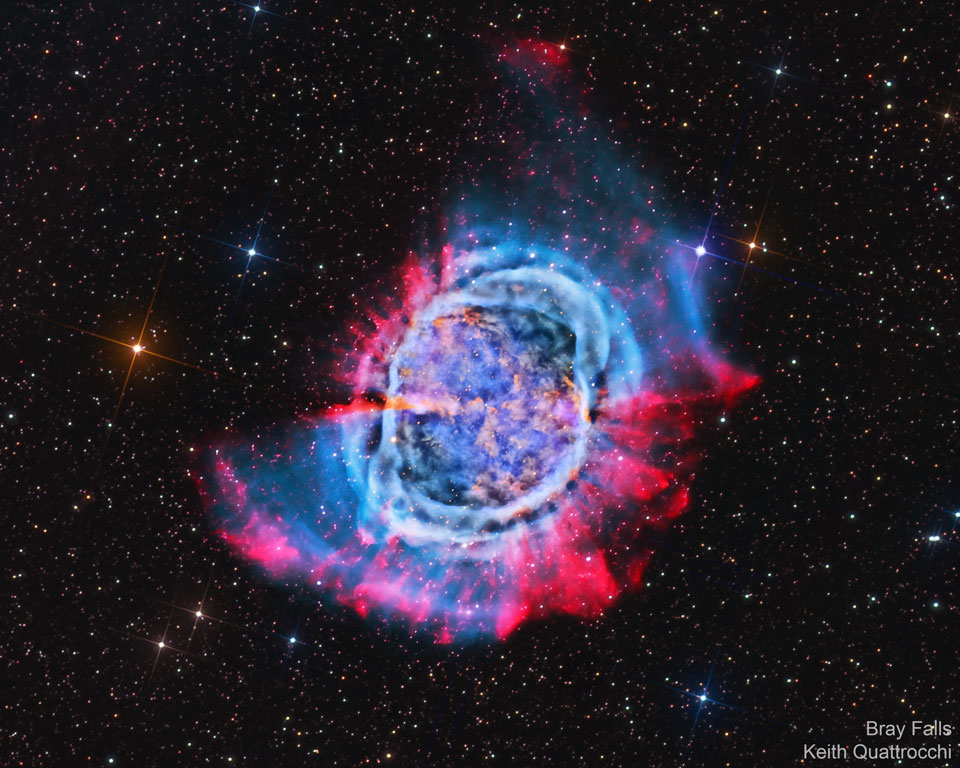Blog
A spectacular lunar halo — known as a 22° halo — formed in the sky above ESO’s La Silla Observatory. The optical phenomenon is a result of moonlight interacting with millions of ice crystals suspended in the atmosphere, forming a ring with an apparent radius of approximately 22° around the moon. It is also known as the “moon ring” or “winter halo”.
While this is a beautiful sight, it creates conditions which are not optimal for astronomical observations. Clouds and the bright light of the moon affect the quality and accuracy of astronomical observations. However, that does not diminish the allure of this ethereal sight, and in fact some stars remain visible. Notably, Sirius, the brightest star in the night sky, can be seen at the top edge of the image, just left of the centre.

Angélique Kpasseloko Hinto Hounsinou Kandjo Manta Zogbin Kidjo (/ˌɒ̃ʒəˈliːk ˈkɪdʒuː, – ˈkɪdʒoʊ/; born July 14, 1960), is a Beninese singer-songwriter, actress, and activist who is noted for her diverse musical influences and creative music videos. In 2007, Time magazine called her “Africa’s premier diva”.
Her musical influences include the Afropop, Caribbean zouk, Congolese rumba, jazz, gospel, and Latin styles; as well as her childhood idols Bella Bellow, James Brown, Nina Simone, Aretha Franklin, Celia Cruz, Jimi Hendrix, Miriam Makeba and Carlos Santana. She has recorded George Gershwin’s “Summertime“, Ravel’s Boléro, Jimi Hendrix’s “Voodoo Child” and the Rolling Stones‘ “Gimme Shelter“, and has collaborated with Dave Matthews and the Dave Matthews Band, Kelly Price, Alicia Keys, Branford Marsalis, Ziggy Marley, Philip Glass, Peter Gabriel, Bono, Carlos Santana, John Legend, Herbie Hancock, Josh Groban, Dr John, the Kronos Quartet, Yemi Alade, Cassandra Wilson and Indonesia’s pop star Anggun. Kidjo’s hit songs include “Agolo”, “We We”, “Adouma”, “Wombo Lombo”, “Afirika”, “Batonga“, and her version of “Malaika“. Her album Logozo is ranked number 37 in the Greatest Dance Albums of All Time list compiled by Vice magazine’s Thump website.
Kidjo is fluent in five languages: Fon, French, Yorùbá, Gen (Mina), and English. She sings in all of them, and she also has her own personal language, which includes words that serve as song titles such as “Batonga”. “Malaika” is a song sung in the Swahili language. Kidjo often uses Benin’s traditional Zilin vocal technique and vocalese.
more...Alan Dawson (July 14, 1929 – February 23, 1996) was a respected jazz drummer and widely influential percussion teacher based in Boston.
He was born in Marietta, Pennsylvania, and raised in Roxbury, Massachusetts. Serving in the Army for Korean War duty, Dawson played with the Army Dance Band while stationed at Fort Dix from 1951–1953. During his tenure, Alan explored the post-bop era by performing with pianist Sabby Lewis. After being released from the Army, Alan toured Europe with Lionel Hampton.
Dawson is best remembered as an early teacher of Tony Williams, and Sawyer Brown drummer, Joseph Smyth. Other former students include: Terri Lyne Carrington, Julian Vaughn, Vinnie Colaiuta, Steve Smith, Kenwood Dennard, Gerry Hemingway, Jeff Sipe, Billy Kilson, and many others. He began teaching at Berklee College of Music in 1957. Dawson suffered a ruptured disc in 1975 which led to him halting his touring schedule, to leave Berklee and limit his teaching to his home in Lexington, Massachusetts.
His teaching style emphasized the music as a whole rather than concentrate on percussion alone. He stressed the importance of learning the melody and structure of the tune to better fulfill the role of accompaniment. For this purpose, he had students play over standards while also singing the melody out loud. He constantly strived for balance between musical ideas and strict technique. He was big on rudiments and wrote extensive exercises intended to be practiced with brushes. He believed using brushes with his “Rudimental Ritual” would reduce stick rebound allowing the sense of “picking up” the sticks. While teaching, Alan also maintained a prolific performing and recording career.
more...Kenneth Napper (born July 14, 1933 in London) is an English jazz double-bassist.
Napper started out on piano as a child and picked up bass as a student at Guildhall School of Music. He entered the British military in the early 1950s, playing with Mary Lou Williams in 1953 during a leave period. After ending his term of duty, he played with Jack Parnell, Malcolm Mitchell, Vic Ash, and Cab Calloway. He was the house bassist at Ronnie Scott’s Jazz Club for several years and played with many British and American jazz musicians in the late 1950s and early 1960s, including Alan Clare, Ronnie Scott, Stan Tracey, Tubby Hayes, Tony Kinsey, Tony Crombie, Jimmy Deuchar, John Dankworth, Pat Smythe, Phil Seamen, Zoot Sims, Carmen McRae, and Paul Gonsalves. Later in the 1960s he worked with Ted Heath, Tony Coe, John Picard, and Barney Kessel, as well as with Gonsalves, Tracey, and Dankworth. In 1970 he played with Stephane Grappelli and moved to Germany, playing with Kurt Edelhagen from 1970 to 1972. While in Germany he focused more on composition and arrangement; later in the decade he moved to the Netherlands, where he arranged for radio ensembles.
more...Woodrow Wilson Guthrie (/ˈɡʌθri/; July 14, 1912 – October 3, 1967) was an American singer-songwriter, and one of the most significant figures in American folk music. His work focused on themes of American socialism and anti-fascism. His music includes songs such as “This Land Is Your Land“, written to oppose the American exceptionalist song “God Bless America“, and has inspired several generations both politically and musically.
Guthrie wrote hundreds of country, folk, and children’s songs, along with ballads and improvised works. His album of songs about the Dust Bowlperiod, Dust Bowl Ballads, was included on Mojo magazine’s list of 100 Records That Changed The World, and many of his recorded songs are archived in the Library of Congress. Songwriters such as Bob Dylan, Phil Ochs, Johnny Cash, Bruce Springsteen, Robert Hunter, Harry Chapin, John Mellencamp, Pete Seeger, Andy Irvine, Joe Strummer, Billy Bragg, Jerry Garcia, Bob Weir, Jeff Tweedy, Tom Paxton, Brian Fallon, and Sixto Rodríguez have acknowledged Guthrie as a major influence on their work. He frequently performed with the slogan “This machine kills fascists” displayed on his guitar.
Guthrie was brought up by middle-class parents in Okemah, Oklahoma,[10] until he was 14, when his mother Nora was hospitalized as a consequence of Huntington’s disease, a fatal hereditary neurological disorder. His father moved to Pampa, Texas, to repay debts from unsuccessful real estate deals. During his early teens, Guthrie learned folk and blues songs from his parents’ friends. He married at 19, but with the advent of the dust stormsthat marked the Dust Bowl period, he left his wife and three children to join the thousands of Okies who were migrating to California looking for employment. He worked at Los Angeles radio station KFVD, achieving some fame from playing hillbilly music; made friends with Will Geer and John Steinbeck; and wrote a column for the communist newspaper People’s World from May 1939 to January 1940.
Throughout his life, Guthrie was associated with United States communist groups, although he did not appear to belong to any. With the outbreak of World War II and the non-aggression pact the Soviet Union had signed with Germany in 1939, the anti-Stalin owners of KFVD radio were not comfortable with Guthrie’s political leanings after he wrote a song praising the Molotov–Ribbentrop Pact and the Soviet partition of Poland. He left the station, ending up in New York where he wrote and recorded his 1940 album Dust Bowl Ballads, based on his experiences during the 1930s, which earned him the nickname the “Dust Bowl Troubadour”. In February 1940 he wrote his most famous song, “This Land Is Your Land“. He said it was a response to what he felt was the overplaying of Irving Berlin‘s “God Bless America” on the radio.
Guthrie was married three times and fathered eight children. His son Arlo Guthrie became nationally known as a musician. Woody died in 1967 from complications of Huntington’s disease. His first two daughters also died of the disease. During his later years, in spite of his illness, Guthrie became an icon in the folk movement, providing inspiration to a generation of new folk and country musicians, including mentoring Ramblin’ Jack Elliott and Bob Dylan.
more...This new image shows the Running Chicken Nebula, a cloud of gas and newborn stars that lies around 6500 light-years away from us in the constellation of Centaurus (The Centaur). Officially called IC 2944, or the Lambda Centauri Nebula, its strange nickname comes from the bird-like shape of its brightest region. The star Lambda Centauri itself lies just outside the field of view.

James Roger McGuinn /məˈɡwɪn/ (born James Joseph McGuinn III; July 13, 1942) is an American musician. He is best known for being the frontman and leader of the Byrds. He was inducted into the Rock and Roll Hall of Fame for his work with the Byrds.
McGuinn was born and raised in Chicago, Illinois, United States. His parents, James and Dorothy, were involved in journalism and public relations, and during his childhood, they had written a bestseller titled Parents Can’t Win. He attended the Latin School of Chicago. He became interested in music after hearing Elvis Presley‘s “Heartbreak Hotel“, and asked his parents to buy a guitar for him. (During the early 1980s, he paid tribute to the song that encouraged him to play guitar by including “Heartbreak Hotel” in his autobiographical show). Around the same time, he was also influenced by country artists and/or groups such as Johnny Cash, Carl Perkins, Gene Vincent, and the Everly Brothers.
https://www.youtube.com/watch?v=vcrddV5N9Xs
more...Albert Ayler (/ˈaɪlər/; July 13, 1936 – November 25, 1970 Cleveland, OH) was an American avant-garde jazz saxophonist, singer and composer.
After early experience playing R&B and bebop, Ayler began recording music during the free jazz era of the 1960s. However, some critics argue that while Ayler’s style is undeniably original and unorthodox, it does not adhere to the generally accepted critical understanding of free jazz. In fact, Ayler’s style is difficult to categorize in any way, and it evoked incredibly strong and disparate reactions from critics and fans alike. His innovations have inspired subsequent jazz musicians.
His trio and quartet records of 1964, such as Spiritual Unity and The Hilversum Session, show him advancing the improvisational notions of John Coltrane and Ornette Coleman into abstract realms where whole timbre, and not just mainly harmony with melody, is the music’s backbone. His ecstatic music of 1965 and 1966, such as “Spirits Rejoice” and “Truth Is Marching In”, has been compared by critics to the sound of a brass band, and involved simple, march-like themes which alternated with wild group improvisations and were regarded as retrieving jazz’s pre-Louis Armstrong roots.
more...Peter Michael Escovedo (born July 13, 1935 in Pittsburg, California) is an American percussionist.
With his two brothers, Pete formed Escovedo Bros Latin Jazz Sextet, before Carlos Santana hired Pete and Coke Escovedo for his group. He led the 14–24 piece Latin big band Azteca. His daughter is singer-percussionist Sheila E..
more...Leroy Vinnegar (July 13, 1928 – August 3, 1999) was an American jazz bassist. Born in Indianapolis, Indiana, United States, the self-taught Vinnegar established his reputation in Los Angeles, California, during the 1950s and 1960s. His trademark was the rhythmic “walking” bass line, a steady series of ascending or descending notes, and it brought him the nickname “The Walker”. Besides his jazz work, he also appeared on a number of soundtracks and pop albums, notably Van Morrison‘s 1972 album, Saint Dominic’s Preview.
more...The 27th object on Messier’s list, now known as M27 or the Dumbbell Nebula, is a planetary nebula, one of the brightest planetary nebulae on the sky — and visible toward the constellation of the Fox (Vulpecula) with binoculars. It takes light about 1000 years to reach us from M27, featured here in colors emitted by hydrogen and oxygen. We now know that in about 6 billion years, our Sun will shed its outer gases into a planetary nebulalike M27, while its remaining center will become an X-ray hot white dwarf star. Understanding the physics and significance of M27 was well beyond 18th century science, though. Even today, many things remain mysterious about planetary nebulas, including how their intricate shapes are created.

Christine Anne McVie (née Perfect; born 12 July 1943) is an English singer, songwriter and keyboardist, best known as one of the three lead vocalists and the keyboardist of Fleetwood Mac, whom she joined in 1970. She has also released three solo albums. She is known for her contraltovocals and her direct but poignant lyrics, which focus on love and relationships. AllMusic describes her as an “Unabashedly easy-on-the-ears singer/songwriter, and the prime mover behind some of Fleetwood Mac’s biggest hits.” Eight of her songs appeared on Fleetwood Mac’s 1988 Greatest Hits album.
In 1998 McVie was inducted into the Rock and Roll Hall of Fame as a member of Fleetwood Mac, and received the Brit Award for Outstanding Contribution to Music. The same year, after almost 30 years with the band, she opted to leave and lived in semi-retirement for nearly 15 years. She released a solo album in 2004. In September 2013, she appeared on stage with Fleetwood Mac at London’s O2 Arena. She rejoined the band in October 2014 prior to their On with the Show tour.
In 2006 McVie received a Gold Badge of Merit Award from Basca, now The Ivors Academy. In 2014 she received the Ivor Novello Award for Lifetime Achievement from the British Academy of Songwriters, Composers and Authors, and was honored with the Trailblazer Award at the UK Americana Awards in 2021. She is also the recipient of two Grammy Awards.
more...John Patton (July 12, 1935 – March 19, 2002) was an American jazz, blues and R&B pianist and organist often known by his nickname, Big John Patton.
Patton was one of the most in-demand organists during the golden era of the Hammond B-3 organs between 1963 and 1970.He recorded extensively for Blue Note and performed or collaborated with Lloyd Price, Grant Green, and Lou Donaldson. Patton had a lower profile in the 1970s but enjoyed a comeback in the 1980s and 1990s, often in collaboration with saxophonist John Zorn. His later music incorporated modal and free jazz.
John Patton, born in Kansas City, Missouri, on July 12, 1935, was an American jazz composer and performer. He developed the nickname “Big John”, not because of his size, but because of a song. “Remember the tune, ‘Big Bad John’? … yeah, well, that’s what they started calling me and at first I didn’t understand it but I love it now. It’s just a name; if it’s going to help you, then boogie on up in there!”
more...Paul Gonsalves (July 12, 1920 – May 15, 1974) was an American jazz tenor saxophonist best known for his association with Duke Ellington. At the 1956 Newport Jazz Festival, Gonsalves played a 27-chorus solo in the middle of Ellington’s “Diminuendo and Crescendo in Blue,” a performance credited with revitalizing Ellington’s waning career in the 1950s.
Born in Brockton, Massachusetts, to Cape Verdean parents, Gonsalves’ first instrument was the guitar, and as a child he was regularly asked to play Cape Verdean folk songs for his family. He grew up in New Bedford, Massachusetts, and played as a member of the Sabby Lewis Orchestra. His first professional engagement in Boston was with the same group on tenor saxophone, in which he played before and after his military service during World War II. Before joining Duke Ellington’s orchestra in 1950, he also played in big bands led by Count Basie (1947–1949) and Dizzy Gillespie(1949–1950).
more...More Posts
- Alekos Vretos Day
- Eric Burdon Day
- Carla Bley Day
- Freddie Roach Day
- World Music with Purna Das Baul Samrat & Manju Das
- Daily Roots with Chrisinti
- Music for Surviving the Pandemic
- Love Your Mom
- Happy Mothers Day 2020
- The Cosmos with Arp 142
- Sly Dunbar Day
- Donovan Day
- Dave Mason Day
- Jimmy Ponder Day
- Mel Lewis Day
- Maybelle Carter Day
- World Music with Anoushka Shankar
- Daily Roots with Sizzla
- Music for Surviving the Pandemic
- Little Richard Memorial